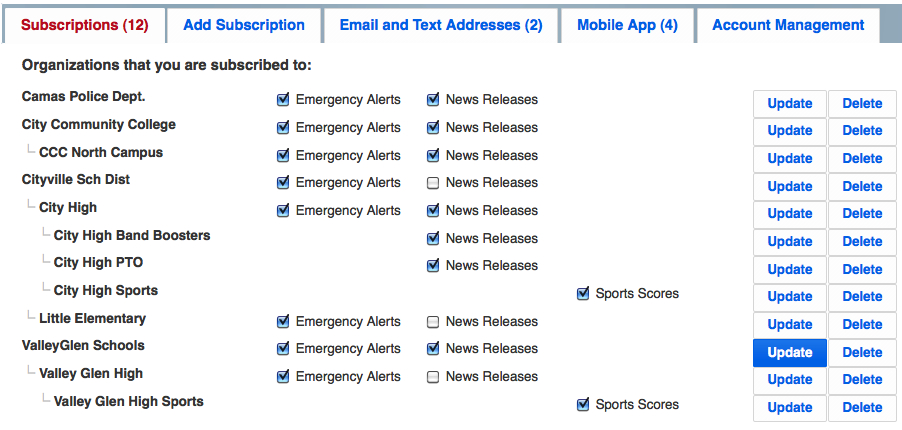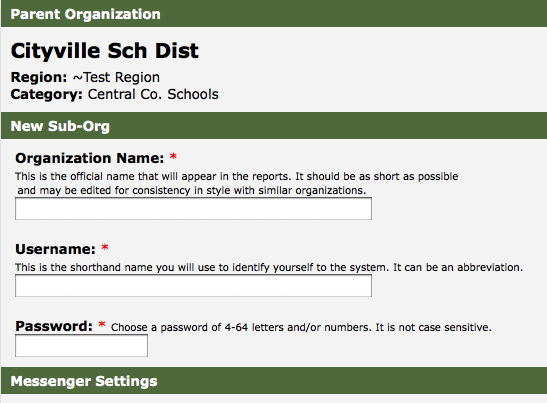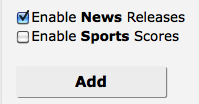
• FlashAlert (FA) Newswire distributes your news (emergency, news releases and high school sports scores) to the media (for on-air and web use) and your Business Partners, and can post your emergency messages to your Facebook and/or Twitter accounts.
• FA Messenger allows the public to create an account and choose which organizations they wish to receive news from via 1) emails and 2) push notifications through the free FlashAlert Messenger iPhone/Android app.
FA Messenger adds much greater capabilities this year. Organizations now can create sub-organizations, up to three levels deep. This allows you to target communications to people interested in news from a specific school, program or other organizational unit.
Here is what a public subscriber’s account might look like:

If someone subscribes to a second-tier org, such as City High, they are automatically subscribed to the top level, Cityville School District, for emergency messages. Subscribing to a third-level sub-org automatically adds you to the emergency lists for the two tiers above. Inclusion of the media for emergency messages and news release (not sports scores) must be initiated by the top-level organization.
When the top-level account administrator creates sub-orgs, he/she assigns each sub-org their own username and password. They start the process by choosing “Add New Sub-Org” as shown below.

This is the initial set-up screen for a new sub-org:


A sub-org administrator (in reality, anyone who has been given the username/password for that sub-org) can post and their information go to Messenger subscribers in any of the three categories: emergencies, news and (high school/college) sports. For emergency items and news, only the top-level administrator can include newsrooms. (Sub-orgs that send sports scores can include sports reporters.)
Since you set up a discrete username/password for each sub-org, postings can be limited to a school principal, PTO president, etc. For sports scores, a team statistician, a parent, journalism student, etc., can post (without having access to the emergency or news channels).
Since FA Messenger was launched nearly a decade ago, the biggest problem we’ve encountered is that cell phone companies sometimes delay or delete emergency text messages. They see a thousand of the same message coming and sometimes set them aside for additional spam scrubbing. A few years ago, on the basis that a message three hours late was worse than no message at all, we set a 90-minute life on the messages. If the cell company doesn’t deliver it in 90 minutes, the message dies.
But there are other problems, too. Some cell companies truncate their messages at 160 characters. (Others break the message into two or more pieces.) With either delays or truncation, the public sometimes is angry and contacts the org or FlashAlert -- and we have no control over it.
People also reply to FA text messages, thinking they are replying to someone else. FlashAlert monitors these accidental replies, and most can be ignored. But an accidental reply that says, “I’ve just gone into labor – meet me at the hospital” needs to be addressed!
This is why we created the free FA Messenger app for Android and iOS. It uses push notification, which enables a peer-to-peer relationship between a subscriber’s phone/tablet and the FlashAlert server. Therefore, no spam filtering is necessary and the messages fly out, tens of thousands per minute. Messages travel the Internet and can be received through wi-fi and/or cell service, but since they no longer go through traditional text message gateways at cell carriers, there is no spam-filtering delay or shortening of messages.
Therefore, starting Sept. 1, 2014, FA no longer will allow registrations of new text message addresses. We will grandfather current text addresses for one more year, with lots of communication to text subscribers during the coming year about the change.
If someone is adamant that they receive a text, they still can enter it as an email address. (AT&T customers, for example, would use the format 10-digit-number@txt.att.net). Here are the formats for the larger cell carriers:
ACS Alaska |
10digit#@txt.acsalaska.net |
Alaska Digitel |
10digit#@alaskadigitel.com |
Alltel |
10digit#@message.alltel.com |
AT&T/Cingular |
10digit#@txt.att.net |
CenturyLink |
10digit#@messaging.centurytel.net |
Cricket |
10digit#@sms.mycricket.com |
GCI |
10digit#@mobile.gci.net |
MetroPCS |
10digit#@mymetropcs.com |
MTA Wireless |
10digit#@sms.mtawireless.com |
Nextel |
10digit#@messaging.nextel.com |
Qwest |
10digit#@qwestmp.com |
Sprint |
10digit#@messaging.sprintpcs.com |
T-Mobile |
10digit#@tmomail.net |
US Cellular |
10digit#@email.uscc.net |
Verizon |
10digit#@vtext.com |
Revised Aug. 1, 2014